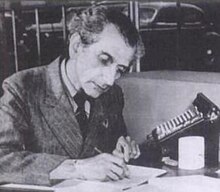Kornel Lanczos
| Cornelius Lanczos | |
|---|---|
 |
|
| Born |
February 2, 1893 Székesfehérvár |
| Died | June 25, 1974 (aged 81) Budapest |
| Nationality | Hungarian |
| Alma mater |
University of Budapest University of Szeged |
| Known for | Lanczos algorithm |
| Spouse(s) | Mária Erzsébet Rump (1928–?) Ilse Hildebrand (1954–1974) |
| Awards | Chauvenet Prize (1960) |
| Scientific career | |
| Fields |
Mathematics Theoretical physics |
| Institutions |
University of Freiburg Purdue University Boeing Institute of Numerical Analysis Dublin Institute for Advanced Studies |
| Thesis | Relation of Maxwell's Aether Equations to Functional Theory (1921) |
| Doctoral advisor | Rudolf Ortvay |
| Other academic advisors | Loránd Eötvös, Leopold Fejér, Franz Himstedt, Erwin Madelung |
Cornelius (Cornel) Lanczos (Hungarian: Lánczos Kornél, pronounced [ˈlaːnt͡soʃ ˈkorneːl], born as Kornél Lőwy, until 1906: Löwy (Lőwy) Kornél) was a Jewish Hungarian mathematician and physicist, who was born on February 2, 1893, and died on June 25, 1974.
He was born in Székesfehérvár to Karl Löwy (Lőwy Károly) and Adél Hahn. Lanczos' Ph.D. thesis (1921) was on relativity theory. He sent his thesis copy to Einstein, and Einstein wrote back, saying: I have read your work in as much detail as my present excess of work allows. I can say that it is sound and original thinking. It makes you worthy of the doctorate. I am pleased to give you my permission to honour me by dedicating it to me. In 1924 he discovered an exact solution of the Einstein field equation representing a cylindrically symmetric rigidly rotating configuration of dust particles. This was later rediscovered by and is known today as the . It is one of the simplest known exact solutions in general relativity and is regarded as an important example, in part because it exhibits closed timelike curves. Lanczos served as assistant to Albert Einstein during the period of 1928–29.
According to a short speech delivered October 1, 2010 during Lanczos' induction to the NIST Portrait Gallery of Distinguished Staff, his daughter-in-law, Alice Lanczos, described his return to Hungary in 1939 from his then-position at Purdue University, when he attempted to convince his family to return to the US with him due to the anti-Jewish Nazi threat. His wife was too ill to travel and died several weeks later from tuberculosis. He was only able to extricate his 5-year-old son and return to the US just before the war began. When the Nazis purged Hungary of Jews in 1944, only his sister and a nephew survived. That son married, moved to Seattle and raised two sons. When his son Elmar looked at his own firstborn son, he said: "For me, it proves that Hitler did not win."
...
Wikipedia
